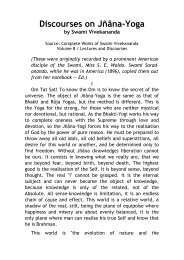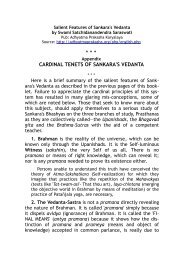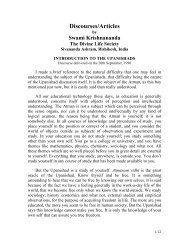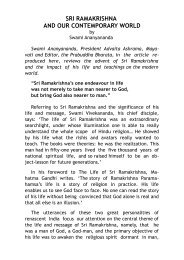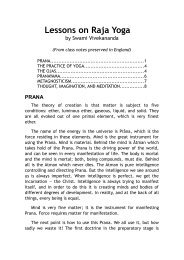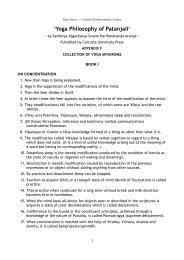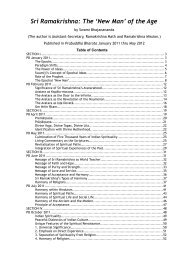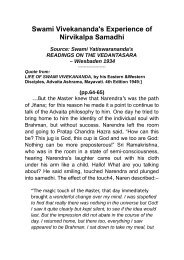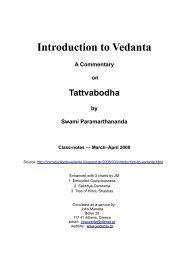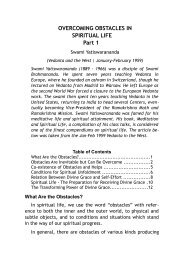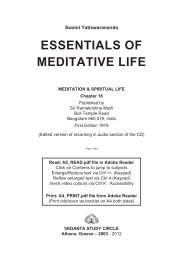4. The Non-manifested - Vedanta
4. The Non-manifested - Vedanta
4. The Non-manifested - Vedanta
Create successful ePaper yourself
Turn your PDF publications into a flip-book with our unique Google optimized e-Paper software.
<strong>The</strong> Eternal Message of the Gita<br />
SWAMI SIDDHESHWARANANDA 1<br />
Source: <strong>Vedanta</strong> Kesari,<br />
January 2004 2<br />
<strong>4.</strong> <strong>The</strong> <strong>Non</strong>-<strong>manifested</strong><br />
At daybreak all that is <strong>manifested</strong> is born from<br />
what is called the non-<strong>manifested</strong> (avyakta). At<br />
nightfall the manifestation merges again into the non<strong>manifested</strong>.<br />
But, superior to this non-<strong>manifested</strong>, there exists<br />
another <strong>Non</strong>-<strong>manifested</strong>, eternal, which does not perish,<br />
when all beings perish. (Gita, VIII.18 & 20.)<br />
Quite naturally, the 'daybreak' corresponds to the <strong>manifested</strong><br />
state of waking (jagrat avasthâ), and 'nightfall' to the<br />
non-<strong>manifested</strong> state of deep sleep (sushupti avasthâ). Normally<br />
the non-<strong>manifested</strong> is considered to be the source, the<br />
cause of the <strong>manifested</strong> which, at a certain time, is again reabsorbed<br />
into it. As far as the dream state (svapna avasthâ)<br />
is concerned, it is part of the <strong>manifested</strong> (cf. the Karika of<br />
Gaudapada and Shankara's commentary on the Mandukya Upanishad).<br />
One may find it surprising that, in the Gita, no mention is<br />
made of the method of avasthâtraya—the study of the three<br />
1 A monk of the Ramakrishna Order, India, Swami Siddheswarananda<br />
(1897-1957) taught <strong>Vedanta</strong> in Europe from 1937-57—he was the Minister-in-Charge<br />
of Centre Védantique Ramakrichna, Gretz, France.<br />
2 This the 4 th of a series of independent commentaries by the Swami on<br />
various themes of the Gita-teachings published in French from Gretz in<br />
their Bulletin des Activités Culturelles No.4, December 1955. English<br />
translation and edit by André van den Brink and René Tien of Centre<br />
Védantique Ramakrichna..
Gita – <strong>The</strong> <strong>Non</strong>-<strong>manifested</strong> – Swami Siddheswarananda<br />
states of waking, dreaming and deep sleep—while other<br />
texts, such as the Uddhava Gita, emphasize its significance<br />
and importance. This objection disappears, however, if one<br />
looks upon the states of waking and dreaming as being of the<br />
same nature inasmuch as both represent the <strong>manifested</strong> aspect,<br />
while deep sleep represents the non-<strong>manifested</strong> aspect.<br />
Similarly we may note that the Gita makes no mention<br />
of another classic position of <strong>Vedanta</strong>, according to which it<br />
is proper to make a distinction between the ultimate Reality<br />
—Brahman, and the apparent reality—Maya (paramarthika<br />
satta and vyavaharika satta). <strong>The</strong> Gita, however, is not a<br />
philosophical treatise like the Viveka-chudamani or the Panchadasi,<br />
but is giving an overview of the conflicts, of the<br />
contradictions of life, and their solutions. <strong>The</strong> commentaries,<br />
the later developments that were inspired by the living words<br />
of Sri Krishna which were full of wisdom, gave birth to various<br />
philosophies, but the Gita itself does not directly refer to<br />
the classical methods of <strong>Vedanta</strong>, whether it be the study of<br />
the three states (avasthâtraya) or the proper study of the superimpositions<br />
(adhyaropa-apavada).<br />
<strong>The</strong>se methods are effective means for attaining the<br />
truth, because the human mind indeed feels the need to understand<br />
life through a system. <strong>The</strong> intuition of the Real itself<br />
comes, most often, only at the end of a long search<br />
carried out according to the particular mental structure of<br />
the seeker. <strong>The</strong> methods of <strong>Vedanta</strong>, having no other object<br />
than to awaken us to the ultimate comprehension, take this<br />
mental structure into account.<br />
Before studying the notions of '<strong>manifested</strong>' and 'non-<strong>manifested</strong>'<br />
with the help of the method of avasthâtraya which is<br />
metaphysical and non-causal, we shall first explain more<br />
fully the point of view of adhyaropa-apavada which is theological<br />
and causal, and which looks upon Brahman, the Reality,<br />
2
Gita – <strong>The</strong> <strong>Non</strong>-<strong>manifested</strong> – Swami Siddheswarananda<br />
as the primal Cause. According to this view our intuition of<br />
the Reality is veiled by samkalpa and vikalpa (volition and<br />
imagination) which are the effects of Maya, the apparent<br />
reality, and thus Brahman, the ultimate Reality, can only be<br />
realized by transcending Maya. This theory is illustrated by a<br />
classic example: When, in the twilight, we mistake a rope for<br />
a snake, the snake is 'superimposed' on the rope. <strong>The</strong> snake<br />
has to disappear so that the rope may appear, for one cannot<br />
see the snake and the rope at the same time. In the same<br />
way Maya, the apparent reality, is superimposed on Brahman,<br />
the ultimate Reality.<br />
<strong>The</strong> realisation of Brahman through the negation of Maya<br />
is a concept common to the two methods quoted above. <strong>The</strong>y<br />
differ, however, in the meaning given to the term 'Maya'. To<br />
Gaudapada who expounds the method of avasthâtraya in the<br />
Mandukya Upanishad, everything that is perceived is Maya.<br />
So, from this point of view, there is sameness of nature<br />
between the states of waking and dreaming, both being characterized<br />
by the perception of objects and thoughts. <strong>The</strong><br />
theory of superimposition, on the other hand, accords a<br />
higher degree of reality to the waking state which it sees as<br />
the cause of the dream.<br />
Indeed, most of the time we are occupied by the search<br />
for the cause, for there is in us a natural need for explanation<br />
and satisfaction, which is an emotional reaction of our<br />
nature. Only a dhira buddhi, a man of superior intelligence,<br />
has the courage to discard the prejudices, the erroneous notions<br />
which are the result of our emotional reactions. He is<br />
no longer bound by an egocentric view of the world, nor by a<br />
belief in the absolute reality of the waking state. Such renunciation,<br />
however extreme it may seem, nevertheless constitutes<br />
the indispensable condition for following the method of<br />
avasthâtraya.<br />
3
Gita – <strong>The</strong> <strong>Non</strong>-<strong>manifested</strong> – Swami Siddheswarananda<br />
Nothing would appear to be more shocking to common<br />
sense than to find the same value being attributed to the<br />
dream and the waking state! And, surely, from the point of<br />
view of the waking state, the dream appears as a remembrance,<br />
the reality of which is completely subjective. But the<br />
search for the truth according to the method of avasthâtraya<br />
requires one to liberate oneself from the notions of 'objectivity'<br />
and 'subjectivity'. Since we are dealing here with a direct<br />
apprehension of the Reality, any intermediary will be repudiated,<br />
in particular the intellectual analysis which divides,<br />
which classifies, and which establishes this distinction<br />
between 'objective' and 'subjective'. It can give but a partial<br />
view of the truth.<br />
Shankara comments as follows on verse 8.18: '<strong>The</strong> non<strong>manifested</strong><br />
is the sleep of the Creator. At daybreak, that is to<br />
say, when Brahmâ wakes up, it is from this non-<strong>manifested</strong><br />
that all creatures—animated and non-animated—are born. At<br />
nightfall, when Brahmâ goes to sleep, all manifestation dissolves<br />
into the non-<strong>manifested</strong>, avyakta.' 3 One sees that<br />
Shankara is looking at the macro-cosmic aspect of the question<br />
that occupies us. But, since this waking and sleeping<br />
condition of Brahmâ can only be studied on the authority of<br />
the Scriptures, we shall be able to understand the commentary<br />
better by looking at the microcosmic aspect, that is to<br />
say, the individual aspect where, every day, we have the experience<br />
of waking and sleeping. Our sleep then corresponds<br />
to the non-<strong>manifested</strong> and our waking state to the manifes-<br />
3 From the cosmic point of view Brahmâ, the creator God, is regarded as<br />
the Cause of the world, and his sleep is the mahâpralaya, the<br />
cessation of all temporal processes (kalpa). This sleep of<br />
God corresponds to mulavidya, the universal ignorance,<br />
and our own sleep to tulavidya, individual ignorance. Of<br />
course these theological notions do not stand the criticism<br />
effected by the buddhi, the higher reason.<br />
4
Gita – <strong>The</strong> <strong>Non</strong>-<strong>manifested</strong> – Swami Siddheswarananda<br />
ted, and in this <strong>manifested</strong> we are to include our dreams as<br />
well.<br />
Since the activity of our mind is pursued within the domain<br />
of causality, we imagine the <strong>manifested</strong> and the non<strong>manifested</strong><br />
to be a succession of states. Avyakta, the non<strong>manifested</strong>,<br />
then seems to be the cause of vyakta, the manifestation,<br />
which would thus exist in avyakta in its potential<br />
state. In verse 8.20 Sri Krishna distinguishes an other non<strong>manifested</strong><br />
which is imperishable. That which does not perish<br />
has never taken birth. <strong>The</strong>refore, Shankara says, we are<br />
dealing here with the akshara, the supreme Brahman (Parabrahman).<br />
In his commentary Shankara adds: 'Although different<br />
from avyakta, one could think of it as being of the same<br />
nature as avyakta. In order to take away this ambiguity Lord<br />
Krishna speaks of “an other non-<strong>manifested</strong>”, thereby indicating<br />
that its nature is different from that of avyakta which<br />
is ignorance itself. <strong>The</strong> akshara does not perish, when all beings,<br />
from Brahmâ to the most minute, have perished.'<br />
<strong>The</strong> one object of the Gita is to show how to attain to the<br />
highest freedom, how to escape suffering and successive rebirths<br />
(samsara). In verse 8.21, Sri Krishna teaches that the<br />
akshara is the highest state that one may realize: 'This supreme,<br />
imperishable <strong>Non</strong>-<strong>manifested</strong> is the final goal. Those<br />
who attain It do not come back any more. That is My supreme<br />
abode.' Ramana Maharshi spoke of it in these terms: '<strong>The</strong><br />
non-<strong>manifested</strong> also exists in your waking state. Even now<br />
you are in the non-<strong>manifested</strong>. You have to become conscious<br />
of it. It is a mistake to think that one enters sushupti (deep<br />
sleep) and that one leaves it. To be conscious of sushupti in<br />
the jagrat (the waking state), this is what is called “jagratsushupti”<br />
or “samadhi”.' Ramana Maharshi is speaking here<br />
of sahaja samadhi which he distinguishes from kevala samadhi<br />
or yoga samadhi.<br />
5
Gita – <strong>The</strong> <strong>Non</strong>-<strong>manifested</strong> – Swami Siddheswarananda<br />
What discipline, then, is one to follow in order to attain to<br />
this supreme <strong>Non</strong>-<strong>manifested</strong> Sri Krishna shows it to us in<br />
the 13 th chapter, where He speaks at length about the 'field'<br />
(kshetra) and the 'Knower of the field' (kshetrajna) (cf.<br />
Chapter V with the commentary on verse 3.2). <strong>The</strong> akshara is<br />
attained when the higher buddhi is awakened and the edifice<br />
of our mental structure collapses.<br />
As long as this mental structure prevails, all our experiences<br />
are interpreted in terms of concepts (time, space and<br />
causality) and divided into various categories. Thus we create<br />
the notions of waking, dream and deep sleep. But, if we look<br />
at our experience of the <strong>manifested</strong> and the non-<strong>manifested</strong><br />
in its intrinsic aspect, we find that it concerns a Totality<br />
(sarvam) and not a totalisation of different elements.<br />
Whereas the non-<strong>manifested</strong> (avyakta) spoken of in verse<br />
8.18, is opposed to the <strong>manifested</strong> (vyakta). <strong>The</strong> <strong>Non</strong>-<strong>manifested</strong><br />
(akshara) of verse 8. 20 (the non-<strong>manifested</strong> of which<br />
Ramana Maharshi speaks) is the intuition of the One who is<br />
without any opposite, who cannot give any hold to our attempts<br />
at fragmentation. When the ego (being the outcome<br />
of ignorance) establishes a subject-object rapport within a<br />
space-time reality, it finds the indivisible All apparently divided<br />
into past, present and future, and into innumerable<br />
parts: 'Indivisible, He dwells in all beings as if He were divided.<br />
He is what supports all beings; He destroys them and<br />
gives birth to them' (Gita, XIII. 16). But, in fact, the Reality<br />
cannot be fragmented, and the different states which we<br />
think to be passing through in the course of our lives, are not<br />
really distinct from one another. <strong>The</strong>se, the Mandukya Upanishad<br />
says, do not appear as the four feet of a cow, but as<br />
one and the same coin that has been artificially divided into<br />
several parts (see Shankara's commentary on the 2 nd mantra<br />
of the Mandukya Upanishad).<br />
6
Gita – <strong>The</strong> <strong>Non</strong>-<strong>manifested</strong> – Swami Siddheswarananda<br />
Indeed, whatever the divisions which the number 'one'<br />
may be subject to, it will always be enlisted with the numerator,<br />
for 'one' cannot be fragmented. (This 'one' who is not<br />
admitted into any one series, who is not the 'one' that is normally<br />
followed by 2, 3, 4, etc., corresponds to the intuition<br />
that we may have of the non-duality [advaita] inherent in<br />
each experience.) This intuition is a direct knowledge<br />
without any mental processing, infinitely more real than the<br />
sensory experience. Sri Ramakrishna, to whom Narendra (the<br />
later Swami Vivekananda) put the question: 'Have you seen<br />
God', replied: 'I see God more clearly than I see you.' This<br />
God is the akshara, the non-<strong>manifested</strong> of which Ramana Maharshi<br />
was said to be conscious of. But here, as one may expect,<br />
it concerns an impersonal comprehension that does not<br />
admit of a perceiver nor of an object perceived.<br />
Gaudapada and Shankara endeavour to take us to that<br />
comprehension by demonstrating that all that which is perceived—the<br />
spectacle—is unreal (Mandukya Karika, II.4). On<br />
the other hand, that which is not perceived is the Real, the<br />
spectator who is eternally present. It may seem paradoxical<br />
and even absurd to enunciate such a proposition: 'What is<br />
perceived is unreal, and what is not perceived is real.' By<br />
'what is not perceived' one should understand 'That which<br />
cannot be perceived in any way'. <strong>The</strong> objection which brings<br />
in the classic examples of unreality such as 'the horns of a<br />
hare' etc., claiming that this line of reasoning would accord<br />
reality to these horns, because one doesn't perceive them,<br />
would be void: <strong>The</strong> very fact of their being conceived is<br />
enough to deprive them of all reality, for a concept, too, is<br />
an idea that is perceived.<br />
<strong>The</strong> spectator is not a particular entity who would stand<br />
aside from the spectacle, for in that case he would immediately<br />
become part of the spectacle and cease to be a spec-<br />
7
Gita – <strong>The</strong> <strong>Non</strong>-<strong>manifested</strong> – Swami Siddheswarananda<br />
tator. Everything which appears in this universe, both in the<br />
mental and in the physical world, belongs to the spectacle.<br />
As to 'That' which is conscious of the spectacle, no one can<br />
apprehend that, no one can describe that: Its very nature is<br />
never to be perceived and, at the same time, never to be<br />
missing.<br />
With the spectator and the spectacle it is as with the clay<br />
and the multiple objects that may be fashioned out of clay:<br />
<strong>The</strong> clay in itself is never perceived. What one is seeing, a<br />
jar for example, is but a form of it. Can one say, nevertheless,<br />
that the clay is an entity distinct from the jar <strong>The</strong>re<br />
are no two things: <strong>The</strong>re is not the clay and the jar. <strong>The</strong> clay<br />
actually appears under this particular form, but there has<br />
never been and there will never be anything but clay: It is<br />
the infinite possibility of form. <strong>The</strong>refore, we will never be<br />
able to perceive the spectator who is Being itself; we only<br />
know its manifestations. At the same time Being can never be<br />
absent: Nothing can exist without That, nothing exists but<br />
That. What, then, is the value of the spectacle from this<br />
point of view <strong>The</strong>re is only Being, the spectator, and the infinite<br />
possibility of spectacles.<br />
In verse 2.16 we find this existential perspective again (cf<br />
chapter 6.2). In this context Shankara shows how, in each act<br />
of perception, a double consciousness, a double vision occurs:<br />
the vision of that which changes (the unreal), and the<br />
vision of that which remains (the Real). In fact, in the same<br />
act of perception five essential characteristics may be distinguished:<br />
asti (Existence), bhati (Luminosity), priya (Love),<br />
nâma (name), and rupa (form). <strong>The</strong> latter two attributes<br />
which correspond to the <strong>manifested</strong>, particularize the object<br />
and, as a result, permit it to be known as an object. Our experience<br />
of space and time is conditioned by the vision which<br />
changes, that of nama-rupa. On the other hand, the intuition<br />
8
Gita – <strong>The</strong> <strong>Non</strong>-<strong>manifested</strong> – Swami Siddheswarananda<br />
of the Real (asti, bhati and priya) is non-dual and transcends<br />
the notions of time and space. But the power of Maya is such<br />
that man becomes attached to that which perishes. Only the<br />
knowledge of the akshara can remove this ignorance. <strong>The</strong> enquiry<br />
(vichara) which gradually eliminates the emotional reaction<br />
and the attachment to the perishable form will make<br />
the seeker conscious of the sole reality of Atman, the Self.<br />
'<strong>The</strong>re are two sorts of visions', Shankara writes in his commentary<br />
on the Brihadaranyaka Upanishad (1.<strong>4.</strong>10), 'the ordinary<br />
vision and the real vision. <strong>The</strong> ordinary vision is a<br />
function of the mind, being effected through the organ of<br />
sight. It is an action and, therefore, it has a beginning and an<br />
end. But Atman is the witness of this ordinary vision, and its<br />
vision is like the heat and the light of fire: Being the very essence<br />
of the witness, it has neither beginning nor end. Because<br />
it appears to be connected with the ordinary vision<br />
(which is a product and but a mode of it), the real vision is<br />
called “the Witness”. In fact, it is itself that which is being<br />
differentiated into witness and vision.'<br />
<strong>The</strong> vision of Atman is the knowledge of the impersonal,<br />
the knowledge of the akshara. This is the highest realisation<br />
which man may attain to. He who reaches that state will<br />
never be deceived any more by the appearances. 'That,' Sri<br />
Krishna says, 'is My supreme abode.'<br />
<br />
Circulated as a service by:<br />
John Manetta<br />
Beles 28 (Koukaki)<br />
117 41 Athens, Greece<br />
Phone: [+30] 210 923 4682<br />
email: jmanveda@otenet.gr<br />
website: www.vedanta.gr<br />
9



